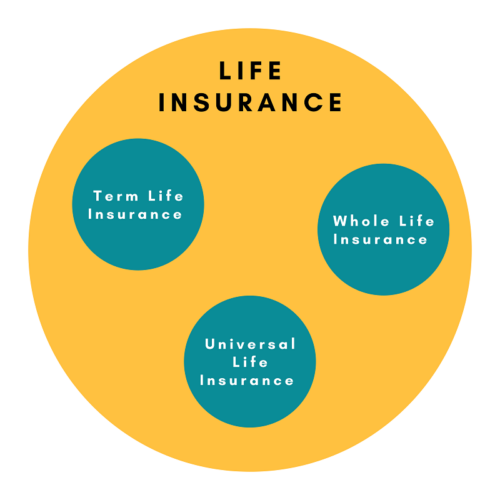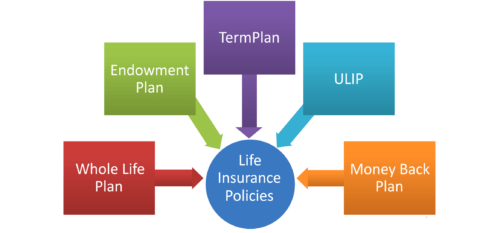This is part of a series. If you have not read the articles that build up to this one, I recommend that you do so first.
- Answering the Question Why About Your Money
- Monkey Brain’s Common Weapons
- Money Comes and Money Goes
- Cracking the Whip on Your Money
No. This isn’t about a hitman coming out to get you.
It’s about protecting your family against losing your potentially biggest asset.
What do you think that is?
Your house? No.
Your car? No.
Your IRA or 401k? No.
It’s your ability to earn an income.
In this and the next article, we’ll look at how insurance can protect your ability to earn an income. There are other reasons to carry insurance, which we’ll also explore, but for most people, this is life insurance’s primary purpose.
Why Buy Life Insurance?

There are three main reasons why you want to buy life insurance.
- You want to provide for your family in case of your untimely death. This is the most common reason why people purchase life insurance. You have people who are dependent on you for your income or for the time you spend in raising or maintaining the family, and on your passing, there would be an undue financial burden on everyone else.
There are two main contexts in which this is important. The first is for a working spouse. That spouse brings in income and the family expects that spouse to bring in income for the foreseeable future until retirement. An untimely death means the end of that stream of income and makes life much more difficult for the rest of the family. The second context is for a stay-at-home spouse who takes care of the kids as a full-time job. In this case, the early demise of the stay-at-home spouse would mean that the surviving spouse would have to hire assistance, either in the form of childcare, or in the form of a nanny or au pair to take care of the kids until they leave the nest. Again, this is an increased financial strain on the survivors.
Thus, the purpose of life insurance for most families is to replace income or to account for increased expenses in the event of the early passing of one of the adults in the family.
Even if you don’t have kids, having life insurance is still important so that the surviving spouse can retain your current standard of living without having to make undue sacrifices. - Special needs planning. This is the case when you have a family member who will not be able to take care of himself or herself without assistance. You are currently taking care of this special needs family member, but you want to make sure that there is enough money to fund a special needs trust to be able to afford care services for the remainder of the special needs family member’s life.
- Estate planning and bequeath purposes. For families who have a net worth which is higher than the amount that would be excluded from federal and state estate taxes, life insurance can be a way to achieve inter-generational wealth transfer or additional charitable giving without having to pay estate taxes. This is one of those cases where trying to implement a do-it-yourself plan isn’t going to work, unless you’re already a trust attorney. Get a good trust and estate planning attorney; the amount you spend getting everything set up and appropriately documented will be worth the money.
For cases 1 and 2, life insurance is appropriate when you don’t already have the funds in place to accomplish those goals. For example, if you already have 50 times your annual expenses saved up in liquid assets, and you’re debt free, then you don’t need life insurance to enable your family to retain the same standard of living.
What if you’re single? Do you need life insurance?
Most planners will tell you no. As long as you have enough money to conduct a funeral, you shouldn’t need more, as your estate will stand good against any debts that you’ve accumulated.
This advice works if you plan on being single and childless for the rest of your life.
However, if you don’t plan on being single and childless for the rest of your life, then you should consider life insurance; it’s a product which is cheaper when you’re younger. That way, when you do get married and have kids, where you’re to the point where others are dependent on you and would be financially harmed by your death, you’ll already be insured. However, when you’re single, not getting life insurance isn’t going to be critical to your life plan.
Types of Life Insurance

There are two basic types of life insurance, although you may hear about different flavors of one type.
- Term life insurance. Term life insurance is insurance set for a given period of time with a specific benefit amount. The price remains the same for the period of time that the term covers and then it expires. Some policies allow you to extend the term when you get close to the end of the term, but you will pay a higher price.
- Whole life insurance. Whole life insurance is designed to be a permanent insurance policy. With it, as long as you continue to pay premiums, you will be insured, no matter how old you get. There are varying types of policies, such as universal insurance, but, at their core, they’re all the same – designed to keep you insured from the day you start the policy until the day you either die or you stop paying.
The payment terms of whole life policies differ dramatically. Some policies have a single premium amount, meaning that you’ll pay the same amount for the rest of your life or for a given time period, and you’ll be permanently insured. To accomplish this, the premiums are higher, relative to term life, when you’re younger, and eventually become lower, relative to term life, when you’re older, since the insurer expects some people to quit paying (called a lapse) or to die. The policy may also keep a cash value which can be used to pay payments and participate in the market, although I have yet to see a policy which performs that particular function as well as actually investing in an index mutual fund.
What Type of Insurance Policy Should You Purchase?

Unless you have an estate that is large enough to trigger the federal estate tax or you have a special needs dependent, then we recommend that you purchase term life insurance. Using whole life insurance as an investment simply does not perform as well as purchasing term life insurance and using the remaining money – what you’d pay to brokers for commissions and for funding the cash value – to invest in the market.
If you have a special needs dependent, then I do recommend whole life insurance because the risk of not setting aside enough money to fund the special needs dependent’s special needs trust during the time period of a term life insurance policy is too great. If you’re close to having the trust fully funded and have reasonable certainty of getting there in a short time period, then term life insurance is acceptable, but in most of the cases, it’s going to be wiser to have a permanent life insurance policy as a buffer.
If you are looking for estate planning purposes or high net worth tax planning, then using a whole life policy can allow you to put more money into a tax-deferred shelter, called a modified endowment contract which will allow you to pass along a higher amount of wealth to your desired beneficiaries or defer your taxes.
Beneficiaries
Before we continue, it is important that you realize the value of naming the correct beneficiaries to your insurance policy. Life insurance proceeds pass estate tax free to named beneficiaries. However, if you fail to name a beneficiary, or you name your own estate as the beneficiary, then your estate will receive the proceeds.
This causes two problems. The first is probate. Probate, the process by which a will is proven valid or invalid by a court and then the instructions in the will are executed, is a time-consuming and sometimes messy affair. In estate planning, you want to avoid probate wherever possible. If the life insurance proceeds are tied up in probate, then your family or your intended recipients won’t have access to those funds. The second problem is that insurance proceeds which pass into your estate are subject to estate tax. You’ll have defeated some of the benefit of life insurance by having the proceeds pass into your estate. Life insurance proceeds that are paid as a lump sum directly to a beneficiary, that is, not your estate, are not taxable.
Furthermore, what is in your estate is subject to whatever your will states, or, if you don’t have a will (which you need to fix ASAP), to the state laws of intestacy. This may result in the life insurance proceeds not going where you intended them to go.
Therefore, it’s important that you correctly name your beneficiaries in your insurance policy, and if your life situation changes, such as getting a divorce or having grandchildren whom you’d like to receive the proceeds, you need to update the beneficiaries as soon as you can.
How Much Insurance to Buy?
If your family faces having to receive a life insurance payment, then you’re going to want for that payment to eliminate all debt and allow for safe withdrawal rates for the remainder of your spouse’s days, and, if necessary, to fund your special needs trust to allow for prudent withdrawals for the remainder of your special needs dependent’s days.
First, let’s address the usual use of life insurance, which is to replace your income to support the family.
In order to know how much insurance you need, regardless of whether or not you’re working or the stay-at-home parent, you need to have a good handle on your debt and remaining term of the debt.
| Type | Balance | Years Left to Pay off |
| Mortgage (including HELOC) | ||
| Student Loans | ||
| Personal/Medical Debt/Car loans > $50,000 |
Note that I did not include small debts. Usually small debts are too small, relatively speaking, to justify insurance policies, and because of the denominations involved with life insurance. It’s impractical to get a $20,000 life insurance policy in most cases.
Next, you need to determine your current annual expenses. You should have this amount after this article and this article. Simply take the monthly expenses from the first article, multiply by 12, and add in the annual expenses from the second article. If you have a stay-at-home spouse, you need to add the annual amount of expenses for child care or having a nanny or au pair to care for the children which having the stay-at-home spouse keeps you from needing to spend. DO NOT include retirement savings in your expense calculations. The lump sum insurance payment will replace retirement savings, as you’ll now have the assets required to replace those expenses; the point of saving for retirement is to accumulate enough assets to be able to safely withdraw those assets when you’re no longer working and not run out of money. We’ll discuss the topic more in an upcoming article.
If you have a special needs dependent, then you will need to calculate the expenses that would be incurred to care for that person if you were not able to do so and add those expenses into the total annual expenses.
| Monthly Regular Expenses | Multiply By | = Annual Regular Expenses |
| 12 |
| Expense | Amount |
| Annual Regular Expenses | |
| Annual Irregular Expenses | |
| Total Expenses |
Once you have your total annual expenses, both regular and irregular, you’ll need to multiply by an age factor to determine how much you’ll need to have to support regular lifetime withdrawals and not run out of money.
Sometimes, you will hear insurance agents and finance gurus say that you need to multiply your income by 12 or 15 or 17 to figure out how much insurance you need. The rule of thumb doesn’t look at your expense picture, which is what is truly important. You’re looking to life insurance to replace a family member’s ability to pay for expenses. That’s why we’re reevaluating your expenses.
We discuss safe withdrawal rates here; these multiplier ratios are a factor of safe withdrawal rates to have a limited chance of running out of money during your lifetime. These are good rules of thumb, but they are rules of thumb.
| Age Range | Multiplier |
| < 30 | 33 |
| 30 – 40 | 30 |
| 40 – 50 | 28 |
| 50 + | 25 |
We have these multipliers because, over time, you should be saving and investing towards your retirement. As your asset base grows, the amount of money you need from insurance should decrease.
Now, let’s calculate how much total insurance you need. When you get to the total required, round up to the nearest $25,000 (e.g. $934,150 becomes $950,000), as most insurance policies are based on these rounded numbers.
| Total Expenses | X Multiplier | Equals | Plus Debt | Total Required |
| X |
How Long to Buy Insurance?
We’re a fan of a concept called laddering for term life insurance. Laddering means that you purchase insurance for the term that you’ll need it for. If you have a special needs dependent, you can still purchase term life insurance to match against the debts while purchasing permanent insurance to meet the spending needs of the special needs trust.
Let’s look at an example.
Let’s say that you have a home mortgage. You’ve lived in the home for ten years, and when you bought the home, you borrowed money on a thirty year mortgage. You now have twenty years left on your mortgage. You should have term life insurance for 20 years in an amount enough to pay off the home. There’s no point to have insurance for longer, since you’ll have the mortgage paid off and won’t need that money.
Additionally, you should be saving money for retirement and increasing your net worth as you go. We’ll address retirement planning later, but for now, we’ll make some assumptions about your saving progress.
Most people work for about 40 years before they retire, and then they fund their retirement with a combination of savings and Social Security. However, their net worth picture does not follow a straight line. They have very little net worth in their younger years and then slowly accumulate wealth, and in the final few working years, compound interest has started to have an effect, and that’s when they, generally, see the biggest gains.
Thus, we’ll base your insurance terms with the assumption that you will be saving and investing for retirement and will make progress along the way. Consequently, when you’re 50, you’ll already have a reasonable amount of money saved for retirement, so won’t need as much insurance to replace the lost income because there will already be some money in the bank.
| # of Years Policy Has Been in Effect | Annual Expense Insurance Coverage Required |
| 0 – 10 | 100% |
| 10 – 20 | 87% |
| 20 – 30 | 50% |
| 30 – 40 | 20% |
Obviously, this is dependent on how successful you’ve been at saving and investing and in income generation as well as at what age you start your insurance, so, again, this is a rule of thumb.
We need to address two exceptions to the rules above:
- Don’t buy insurance beyond when you plan on retiring. If you’re 50 and plan on retiring at age 65, then you only need to buy 10 and 20 year term policies.
- If your insurer doesn’t sell 40 year term policies. If this is the case, add the amount from the 40 year policy into the 30 year policy and buy a 30 year policy for the combined amount that you calculate for 30 year and 40 year policies.
An example
Jay Gatsby and his wife Daisy have a one year old child. Jay is 27 and his wife is 26. They both work.
Jay makes $50,000 a year and Daisy makes $75,000 a year, for a combined income of $125,000 per year.
They have the following debts:
| Type | Balance | Years Left to Pay off |
| Mortgage (including HELOC) | $200,000 | 28 |
| Student Loans | $100,000 | 12 |
| Personal/Medical Debt > $50,000 | N/A |
Their annual expenses are:
| Expense | Amount |
| Annual Regular Expenses | $65,000 |
| Annual Irregular Expenses (Article 5) | $20,000 |
| Total Expenses | $85,000 |
Thus, based on the multiplier, the amount of insurance they need is:
| Total Expenses | X Multiplier | Equals | Plus Debt | Total Required (rounded) |
| $85,000 | X 33 | $2,805,000 | $300,000 | $3,125,000 |
Now, let’s consider how much insurance they need over time.
| # of Years Policy Has Been in Effect | Annual Expense Insurance Coverage Required | Amount Required | Plus Debt to be Serviced | strong>Total (rounded) |
| 0 – 10 | 100% | $2,805,000 | $300,000 | $3,125,000 |
| 10 – 20 | 87% | $2,440,350 | $300,000 | $2,750,000 |
| 20 – 30 | 50% | $1,402,500 | $200,000 | $1,625,000 |
| 30 – 40 | 20% | $561,000 | $0 | $575,000 |
Since Daisy makes 60% of the income, she should have 60% of the total insurance coverage. She would buy the following policies:
| Term | Amount |
| 40 years | $350,000 (60% * $575,000 rounded to nearest $25,000) |
| 30 years | $650,000 (60% * difference between $1,625,000 and $575,000 rounded to nearest $25,000) |
| 20 years | $675,000 (60% * difference between $2,750,000 and $1,625,000 rounded to nearest $25,000) |
| 10 years | $225,000 (60% * difference between $3,125,000 and $2,750,000 rounded to nearest $25,000) |
Since Jay makes 40% of the income, he should have 40% of the total insurance coverage. Since we’ve already figured out Daisy’s share, we simply need to subtract to get Jay’s share.
| Term | Amount |
| 40 years | $225,000 ($575,000 minus $350,000) |
| 30 years | $400,000 ($1,625,000 minus $575,000 minus $650,000) |
| 20 years | $450,000 ($2,750,000 minus $1,625,000 minus $675,000) |
| 10 years | $150,000 ($3,125,000 minus $2,750,000 minus $225,000) |
Insurance for Stay at Home Parents
Stay at home parents need insurance too. If the stay at home parent were to pass, then the remaining parent would face additional expenses in caring for the child – expenses that are removed by having a stay at home parent. To calculate the value of a stay at home parent, we recommend determining the annual cost of having a full-time nanny. If the child is under age 8, multiply that cost by 12, and purchase a 20 year policy for that amount. If the child is over age 8, multiply that cost by 8, and purchase a 10 year policy for that amount.
We’ve looked at one of the functions of insurance, which is to protect your family in case you meet your maker before you expected to. In the next article, we’ll examine how to protect yourself in case you get sick or injured and can no longer work.
Author Profile
- John Davis is a nationally recognized expert on credit reporting, credit scoring, and identity theft. He has written four books about his expertise in the field and has been featured extensively in numerous media outlets such as The Wall Street Journal, The Washington Post, CNN, CBS News, CNBC, Fox Business, and many more. With over 20 years of experience helping consumers understand their credit and identity protection rights, John is passionate about empowering people to take control of their finances. He works with financial institutions to develop consumer-friendly policies that promote financial literacy and responsible borrowing habits.
Latest entries
 Low Income GrantsSeptember 25, 2023How to Get a Free Government Phone: A Step-by-Step Guide
Low Income GrantsSeptember 25, 2023How to Get a Free Government Phone: A Step-by-Step Guide Low Income GrantsSeptember 25, 2023Dental Charities That Help With Dental Costs
Low Income GrantsSeptember 25, 2023Dental Charities That Help With Dental Costs Low Income GrantsSeptember 25, 2023Low-Cost Hearing Aids for Seniors: A Comprehensive Guide
Low Income GrantsSeptember 25, 2023Low-Cost Hearing Aids for Seniors: A Comprehensive Guide Low Income GrantsSeptember 25, 2023Second Chance Apartments that Accept Evictions: A Comprehensive Guide
Low Income GrantsSeptember 25, 2023Second Chance Apartments that Accept Evictions: A Comprehensive Guide

